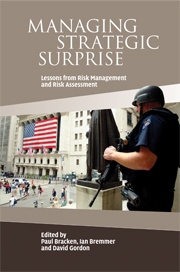Book contents
- Frontmatter
- Contents
- List of figures
- List of tables
- List of contributors
- Acknowledgements
- 1 Introduction
- 2 How to build a warning system
- 3 Intelligence management as risk management: the case of surprise attack
- 4 Nuclear proliferation epidemiology: uncertainty, surprise, and risk management
- 5 Precaution against terrorism
- 6 Defense planning and risk management in the presence of deep uncertainty
- 7 Managing energy security risks in a changing world
- 8 What markets miss: political stability frameworks and country risk
- 9 The risk of failed-state contagion
- 10 Conclusion: managing strategic surprise
- Index
- References
5 - Precaution against terrorism
Published online by Cambridge University Press: 14 May 2010
- Frontmatter
- Contents
- List of figures
- List of tables
- List of contributors
- Acknowledgements
- 1 Introduction
- 2 How to build a warning system
- 3 Intelligence management as risk management: the case of surprise attack
- 4 Nuclear proliferation epidemiology: uncertainty, surprise, and risk management
- 5 Precaution against terrorism
- 6 Defense planning and risk management in the presence of deep uncertainty
- 7 Managing energy security risks in a changing world
- 8 What markets miss: political stability frameworks and country risk
- 9 The risk of failed-state contagion
- 10 Conclusion: managing strategic surprise
- Index
- References
Summary
Terrorism poses a serious risk to health, safety and the environment. Using conventional methods such as bombs or aircraft, terrorism can cause dozens to thousands of human fatalities, spread toxic plumes of smoke, and trigger widespread fear and restrictions on civil liberties. Using weapons of mass destruction (WMD) – chemical, biological or nuclear weapons – terrorism could inflict much greater harm, perhaps millions of deaths and irreparable ecological devastation. Managing the risk of terrorism has become the paramount concern of many governments. Yet the sources of terrorism are highly uncertain, very difficult to assess and manage, and intent on evading preventive measures.
Governments have many options for managing threats to national security. After several decades of pursuing deterrence and containment against the Soviet Union, the US won the Cold War, only to be stunned by the terrorist attacks of September 11, 2001. Concerned that deterrence and containment would not succeed against non-state actors willing to commit suicide attacks, and loath to repeat the mistake of 9/11 (perhaps next time involving WMD), the Bush administration adopted a new National Security Strategy in September 2002. The UK government took a similar stance. This new strategy calls for anticipatory attacks against potential enemies with uncertain capacities and intentions, even before their threat is imminent. Rather than wait for evidence of WMD, it shifts the burden of proof, obliging “rogue” states to show that they do not harbor WMD or terrorist cells, or else face the possibility of attack.
- Type
- Chapter
- Information
- Managing Strategic SurpriseLessons from Risk Management and Risk Assessment, pp. 110 - 183Publisher: Cambridge University PressPrint publication year: 2008
References
- 5
- Cited by

